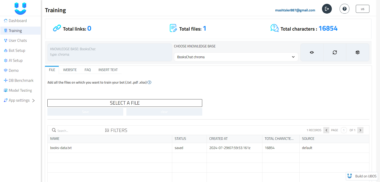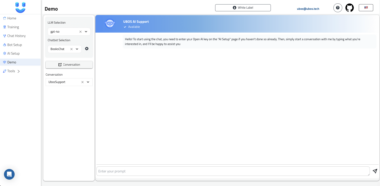Overview of MCP Server for Claude on UBOS Platform
The MCP Server for Claude is a sophisticated implementation designed to offer secure, read-only access to files within a specified directory. This is accomplished through a Model Context Protocol (MCP) server, which acts as a bridge for AI models, enabling them to access and interact with external data sources and tools. This integration is particularly useful for businesses looking to leverage AI capabilities in a secure and efficient manner.
Key Features
- MCP Resource Exposure: Files are exposed as MCP resources using the
file://URI scheme, allowing seamless integration with AI models. - File Search Capabilities: The server provides robust file search functionalities through MCP tools, making it easier to locate and access necessary files.
- Security Measures: With features like path traversal protection and MIME type detection, the server ensures that data access remains secure and compliant with industry standards.
- Gitignore Compliance: The server respects
.gitignorepatterns, ensuring that unnecessary files are not exposed to AI models.
Use Cases
- Enterprise Data Management: Businesses can use the MCP Server to manage and access large volumes of data securely, facilitating better decision-making and operational efficiency.
- AI Model Training: By providing AI models with secure access to data, the MCP Server aids in the training and refinement of AI models, leading to more accurate and reliable outputs.
- Cross-Platform Integration: The server’s compatibility with both macOS and Windows ensures that enterprises can integrate it into their existing infrastructure without significant changes.
Installation and Usage
Installation
To install the MCP Filesystem Python, use the following command:
uv add mcp-filesystem-python
Running the Server
Once installed, the server can be run using:
uv run src/filesystem/server.py /path/to/directory
Claude Desktop Integration
The MCP Server seamlessly integrates with Claude Desktop, providing configuration examples for both macOS/Linux and Windows. These configurations ensure that the server can be tailored to meet the specific needs of different operating systems.
Configuration Examples
- macOS/Linux: Place the configuration file at
~/Library/Application Support/Claude/claude_desktop_config.json - Windows: Place the configuration file at
%AppData%Claudeclaude_desktop_config.json
Development and Licensing
For developers looking to customize or extend the MCP Server, the source code is available under the MIT License. Developers can clone the repository, create a virtual environment, and sync requirements using the command uv sync.
UBOS Platform Integration
UBOS is a full-stack AI Agent Development Platform focused on bringing AI Agents to every business department. Our platform helps orchestrate AI Agents, connect them with enterprise data, and build custom AI Agents using LLM models and Multi-Agent Systems. The MCP Server for Claude is a key component of this ecosystem, providing secure data access and integration capabilities that enhance the functionality of AI Agents.
In conclusion, the MCP Server for Claude on the UBOS Platform is an invaluable tool for businesses looking to harness the power of AI while ensuring data security and compliance. Its robust features and seamless integration capabilities make it an ideal choice for enterprises across various industries.
MCP Filesystem Python
Project Details
- punkpeye/mcp-filesystem-python
- MIT License
- Last Updated: 4/20/2025
Recomended MCP Servers

A Model Context Protocol server that provides real-time hot trending topics from major Chinese social platforms and news...

An MCP server that provides real-time football data based on the SoccerDataAPI.
An advanced MCP server for Home Assistant. 

A Model Context Protocol (MCP) server that provides tools for fetching and analyzing Reddit content.


A Model Context Protocol (MCP) server to provide git tools for LLM Agents
Databutton MCP Server

 From vibe coding to vibe deployment. UBOS MCP turns ideas into infra with one message.
From vibe coding to vibe deployment. UBOS MCP turns ideas into infra with one message.






